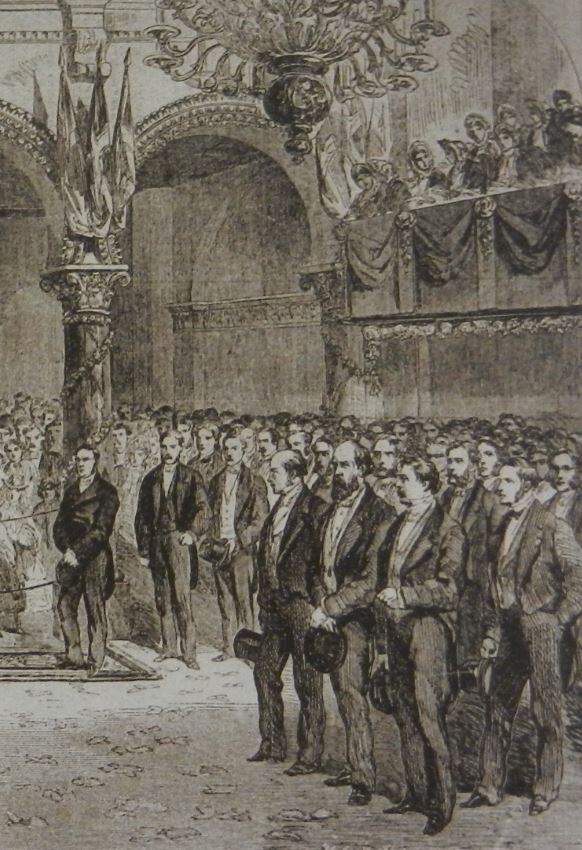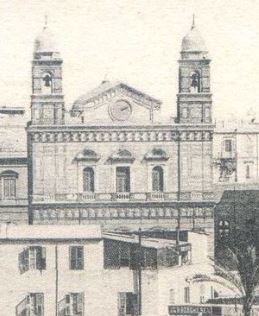

Home News & Events Study Research Members & Staff Publications Friends of the Hellenic Institute Contact Us
The Greek Community in London (1500-1945)
Introduction
The Hellenic Institute acts as a forum to encourage and co-ordinate research into the history of the Greek presence in London across the centuries, from the few, rather obscure individuals of the Tudor and Stuart periods, to the wealthy and influential community of Victorian times and beyond.
Background
The Greek presence in London dates back to at least the early fifteenth century, when Andronikos and Alexios Effomatos, two craftsmen from Constantinople, were granted permission by King Henry VI to remain in the city and pursue their trade. In the centuries which followed Greeks were not uncommon visitors, whether as merchants, mariners, soldiers, diplomats or refugees. Most passed on after a short stay, but some settled permanently. Individual Greeks came to play an prominent role in London's economic and social life. A tailor from Crete, Peter de Mellan, supplied gowns to the Lord Chancellor, Thomas Cromwell (1485-1540), and Constantine Rhodocanaces (Konstantinos Rodokanakis) of Chios became a physician in the service of King Charles II (1660-85). In the 1700s, the Grecian Coffee House, founded and owned by George Constantine from the island of Scopelos in the Northern Sporades, became a noted meeting place for scholars and politicians, numbering among its patrons two presidents of the Royal Society, Sir Isaac Newton and Dr Hans Sloane.
Most of the Greeks of London, however, were of humble origin, mainly sailors who served on the merchant ships that plied between England and the eastern Mediterranean. In 1677 a church was opened for their use on the edge of the city in Soho, the site still being remembered in the name Greek Street. This proved to be short-lived and from 1716 the only Orthodox places of worship in London were the successive Russian embassy chapels which were located at a number of different locations until moving to Welbeck Street in 1813.
During the 1820s, the situation changed rapidly. The outbreak of the Greek War of Independence triggered savage reprisals against the Greek population of the Ottoman Empire by the Turkish authorities, forcing wealthy merchants from Constantinople and Chios to flee abroad. Many went to London where they re-established their businesses and came to dominate Baltic trade. Foremost amongst these new arrivals was Pandias Stephen Ralli (1793-1865), who emerged as the leader of the now burgeoning community. In 1837 a Greek Orthodox chapel was established in a house in Finsbury Circus, followed in 1850 by a small but elegant church in London Wall (the image to the right shows its interior). Finally in 1879, a splendid new church dedicated to Saint Sophia, the Holy Wisdom, was opened on Moscow Road in Bayswater. In 1922, Saint Sophia became the cathedral of the newly-created Greek Orthodox Archdiocese of Thyateira and Great Britain. A second Greek Orthodox place of worship in London, All Saints, was opened in a converted Anglican church in Camden Town in 1948. Today there are more than two dozen Greek Orthodox churches and chapels across the greater London area.
In the years after the inauguration of Saint Sophia, some of the wealthier members of the Greek community were assimilated into the British upper middle classes. Many been born in Britain and educated at public schools, particularly Harrow and Westminster. Some played a prominent role in philanthropy and public life. Constantine Ionides (1833-1900) bequeathed his substantial art collection to the Victoria and Albert Museum, where most of the paintings, including works by Rembrandt, Degas, Delacroix, are now on public display. Pandeli Thomas Ralli (1845-1928) was MP for Bridport from 1875 to 1880, Lucas Ralli (1846-1931) was created a Baronet in 1912, and Emmanuel Rodocanachi (1855-1932) was a director of the Midland Bank. Helena Schilizzi (1873-1959), who belonged to a prominent Anglo-Greek family, married the Greek statesman Eleftherios Venizelos in London in 1921. The history of the Greek community in London during the nineteenth and twentieth centuries, therefore, presents a picture of steady progress from an obscure minority to a position of considerable wealth and influence.
Research
To date, the Hellenic Institute has supported five research projects related to the Greek presence in London:
Leoni Thanasoula (British School at Athens Centenary Bursary Holder 2015-16) is currently investigating the life and times of Anastasios Agathidis (c. 1818-1881), a scholar from Prousos in Evrytania, who arrived in England in 1843. After working as a private tutor for the Trikoupis and Ralli families and as Anagnostes (Reader) for the Church of Saint Sophia in London, he devoted his energies to encouraging educational initiatives in his native town in Greece.
Nil Palabiyik-Pektas (The John Rylands Research Institute, Manchester) examined the life and work of Nikodemos Metaxas, a monk from the Venetian-controlled island of Cephalonia who learned the art of printing in Fleet Street and transported a printing press from London to Constantinople in 1627. She was awarded a PhD by Royal Holloway in 2014 for her doctoral thesis entitled The First Greek Printing Press in Constantinople, 1627-1628.
Quentin Russell studied the Greek presence in London during the period 1830-1914, with particular reference to the Anglo-Greek art patrons of the later nineteenth century. He was awarded a PhD by Royal Holloway in 2011 for his doctoral thesis entitled The Greek Community in Victorian London: Identity, Community and Assimilation.
Evangelia Georgitsoyanni (Harokopian University, Athens) investigated the life of Leonidas Arniotis (1862-1939), an Athenian theatre director. Arniotis spent the latter part of his life in London, where he owned a bookshop and cafe in St. Giles's High Street.
Jonathan Harris (Department of History, RHUL) investigated the little-known history of the Greek community in London between 1500 and 1800 and published a series of works on the subject.
Further Reading
Evangelia Georgitsoyanni, 'An unknown verse newspaper of the Greek diaspora', Analele Universitstii "Stefan Cel Mare" Suceava: Serie Filologie B. Literatura 11 (2005), 45-64
Jonathan Harris, 'Silent Minority: the Greek Community of Eighteenth-Century London', in Greek Diaspora and Migration since 1700, ed. Dimitris Tziovas (Aldershot, 2009), pp. 31-43
Jonathan Harris, 'The Grecian Coffee House and political debate in London, 1688-1714', The London Journal 25 (2000), 1-13
Jonathan Harris, Greek Emigres in the West, 1400-1520 (Camberley, 1995)

